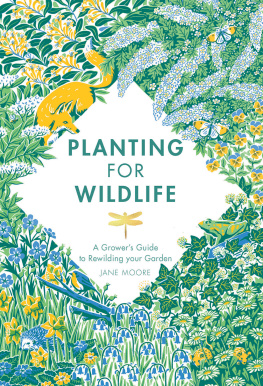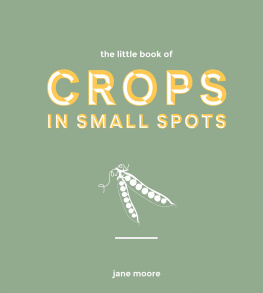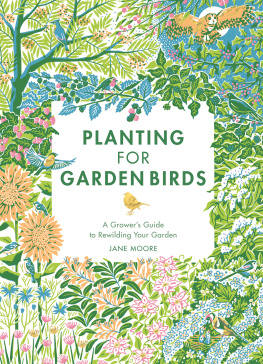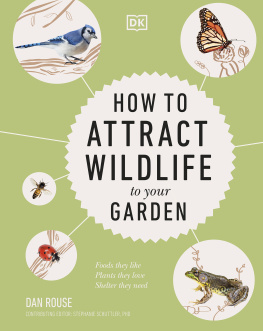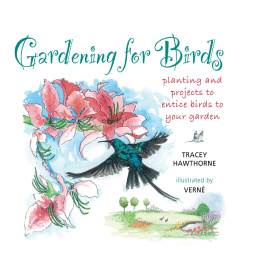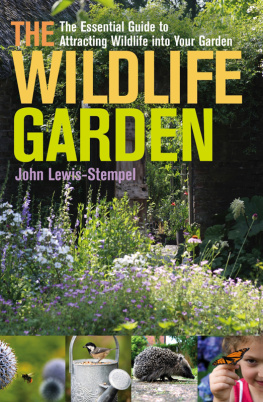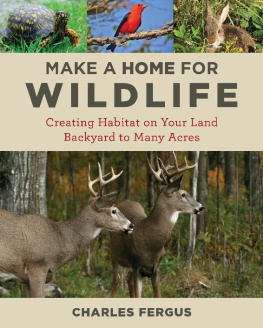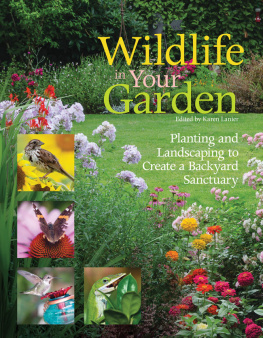To Annie and Haydn

For me, the joy of gardening is about far more than simply a love of plants. Its about creating a little world of my own, my own little slice of paradise, which is far from perfect but a haven nonetheless. My garden is not just a sanctuary for me theres a whirlwind of summer visitors such as butterflies and bees, plus winter regulars like blue tits and the odd bumblebee, as well as permanent residents such as blackbirds, the robin and the fat toad that lives at the bottom of the wall.
To my mind, gardening is also about the wild lives I share my little corner of this planet with: the flurry of a flock of small birds flitting from shrub to tree, the footprints of a fox in the snow, the whirr of a dragonfly hovering in front of me as I weed around the pond.
While I love the plants simply for themselves, the way they create the safe, quiet places that make the wildlife feel at home is equally important. Some plants and gardens are able to do that better than others, but all gardens from a large countryside plot to a small urban backyard have huge potential. It really doesnt take much to start gardening from a wildlife point of view chances are youre doing a lot of things right already but a lot of it is about loosening your approach and thats about changing your way of thinking as much as anything else. Instead of being a static, picture-perfect extension of the house, the garden that is planted for wildlife is ever-changing, vibrant setting that will bring in bees, butterflies, birds and all sorts of other wildlife. You only have to make a few simple changes, such as letting part of your garden run a little wild or choosing plants with wildlife in mind, and youll be surprised what living things find their way in.

I t might seem like your garden or backyard is just a tiny dot on the face of the planet, but every little thing you do has an environmental impact to a greater or lesser degree. From small actions, huge changes can develop. It might come as a surprise, but its so easy for us gardeners to make a difference to the wildlife in our area, and the wider country as a whole. In the UK alone, private gardens cover a massive 667,000 acres (270,000 hectares) thats a lot of potential space for wildlife to thrive. And awareness of the importance of the local possibilities is growing worldwide. In the USA, within just the past few years, 23 million Americans have converted part of their lawn to a natural or wildflower landscape, 14 per cent have bought plants native to where they live and one in four adults has bought a plant specifically because it was beneficial to bees, butterflies or birds. Thats a lot of plants and a lot of people thinking about how to improve their backyards for wildlife.
Thanks to recent campaigners such as Greta Thunberg and the Extinction Rebellion movement, we are becoming increasingly aware of our impact on the world. Wildlife gardening is about encouraging nature to take back much of the control, allowing the beauty and diversity of the natural world to make a difference to our lives and hopefully the planet. Our role is simply to guide our garden in the right direction, making it an hospitable and welcoming place for wildlife to visit and perhaps make a home.
Thats easy to say, but few of us want a garden thats a total wilderness. In real terms, its primarily about changing your way of thinking: instead of considering your garden as a managed zone that is under your strict control, see it as a green space that is a part of nature and shared by you and your family with local wildlife. let go of your preconceptions of what a garden should be and instead regard it as a space to be shared with other creatures. By relaxing your gardening style and opening up enclaves for wildlife to create habitats that evolve into a mini ecosystem right outside your door, you will discover a new freedom to work with, rather than against, nature.
Its all a question of balancing your needs and wishes for your garden with those of wildlife and you might be surprised to realize youre somewhat in tune. We want peace, seclusion and privacy and so do most wild creatures. We aim for foliage and flower interest for a long season which also suits plenty of insects. We also want space to sun ourselves, eat outside and enjoy summer evenings all activities that wildlife is busy doing before we get up in the morning, while were at work and after weve gone to bed.
A few small changes are all it takes to make your garden the kind of haven that wild things love. it doesnt need to be a muddled mess of only native plants; instead your garden should be abundant with flowers, fruit and foliage, filled with flitting birds and buzzing with insects. By the way, those insects dont spell utter doom for your kitchen garden and roses the UK has something like 22,400 species of insect and relatively few of them are pests. Most of them are creatures we want to encourage pollinators such as bees and butterflies, and parasites and predators such as ladybirds (ladybugs), lacewings, spiders and wasps. Even inconsequential woodlice and earthworms do a fantastic job of munching their way through plant material, creating compost and enriching the soil, without you having to lift a finger. Every little thing has its own important part to play, including those we barely notice, such as earthworms, and those we never even see, including soil bacteria and other microorganisms.
EARTHWORMS
Its so often the little creatures that make a massive difference. The humble earthworm does an incredible job of breaking down organic matter and creating good soil, providing the basis for plants to grow. Without the earthworm the world would be a very different place. There would be no soil to speak of, no rotting down of leaves and waste.
Of course, when we think of earthworms, most of us think of them as simply food for the birds: we picture them stretching like elastic as hungry birds pull them from the soil. While this partly accounts for their importance to your garden ecosystem, the earthworm has a much bigger role to play. They might not be the most exciting creatures you hope to attract to your garden, but they nonetheless play a vital part in ecosystems across the world, let alone that of your garden.
Earthworms, along with bacteria and fungi, digest decomposing plant material, enriching the soil hugely as they do so. Amazingly, theyre responsible for processing between 2 and 20 tonnes (0.9 and 9 tons per acre) of organic matter per hectare per year, depending on how much matter is available. This process unlocks vital nutrients such as phosphorus and nitrogen, making them accessible to plants right where it matters, near their roots.
Not only that, but the very way earthworms tunnel and burrow improves soil structure beyond measure. They open up spaces in the soil, allowing water and soluble nutrients to permeate, encouraging roots to grow and develop more fully, and aerating the structure of the soil, all of which makes for healthy, happy plants.

L ets be honest, we think of the garden as our patch, a space that should be organized with the emphasis on how we want to use it, with wildlife and its needs pretty far down the list. Many gardens are arranged to a similar formula, incorporating a mown lawn, flowerbeds, car-parking area, patio and barbecue space, and so on. But most of these areas except perhaps the flowerbeds are barren wastelands when it comes to wildlife. Imagine youre a little bird the wide-open expanse of the patio, parking space and even the lawn become potentially dangerous zones where a predatory bird could swoop down and grab you.

